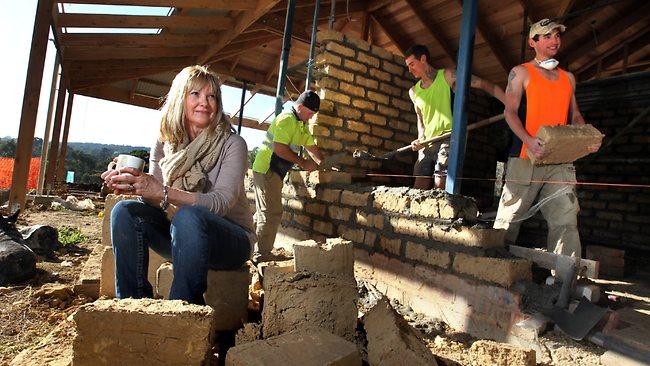'Muddies' fall foul of green ruling
ARCHITECT Robert Marshall has prided himself on doing his bit for the environment by designing and building mudbrick homes.

FOR most of architect Robert Marshall's working life he has prided himself on doing his bit for the environment by designing and building mudbrick homes. Sometimes humble and sometimes sprawling, the dwellings have served their owners well over many years.
The handmade mudbrick -- natural subsoil mixed with straw and water, and dried by the sun -- symbolises Earth's sustainability, green values and a low carbon footprint. From hippies putting up bush huts, to the well-off building impressive mansions, most agree on the insulation quality and energy efficiency of mudbrick.
"It's a beautiful way to live and nowadays everyone has to be thinking about the environment," says Julie McKellar, who will move into her new mudbrick home in December.
But her architect, Marshall, whose creations had previously achieved compliance with Australian building codes, and many others in the earth building industry, are now at their wits' end. Some are on the verge of admitting defeat to federal and state bureaucracies, which do not recognise the environmental value of the mudbrick.
Over the past eight years the rollout of increasingly stringent and mandatory energy-efficiency ratings for new homes has made it significantly harder for "muddies", some of Australia's most passionate environmentalists, to get building approval.
But since the adoption two months ago of the even tougher six-star rating, designed to limit carbon emissions by reducing the amount of heating and cooling required by homes, the earth building industry says it may be doomed. Marshall said the McKellar home could not be built under the new six-star regime. New rammed-earth houses are similarly affected.
Builder Stephen Dobson, of the Earth Building Association, told The Australian that the previous ratings made compliance difficult but that the new six-star rating was "decimating the industry".
"The star ratings have been a disaster for earth building and it is getting worse," he said. "Earth builders say now that the regulations make it too hard. The energy ratings are biased and based on models that do not assume real life -- they don't reflect the actual behaviour of people in these homes. As a result, the earth building industry is in serious decline."
The difficulty is ironic. According to independent studies, "muddies", and those who build with rammed earth, are often people with "eco-centric attitudes, values and behaviours". They use less power and have correspondingly lower carbon footprints.
While mudbricks have been a sustainable building material for thousands of years, they cannot readily satisfy energy-efficiency standards. Part of the problem is that the solid mudbrick wall, which is 25cm thick, does not rely on additional insulation, so it scores poorly when measured by official energy rating tools.
By contrast, the ratings tools give the green light to most new houses built with modern materials which have a much higher carbon footprint, having required large amounts of energy during manufacture.
"It is utterly frustrating because we know how environmentally friendly mudbrick homes are," Marshall said. "The carbon issue does not make sense -- making a mudbrick requires very little energy, unlike the manufacture of conventional building materials like a kiln-fired house brick, which require a huge amount of energy.
"In my view the bureaucrats have this all back-to-front. Their energy ratings do not consider the lifestyles and attitudes of mudbrick people, who are low-carbon emitters. Most mudbrick people are very concerned about the environment. They are as gobsmacked as we are that with the new six-star rating it is almost impossible to build their home unless we make significant design changes."
Sigmund Jurgensen, who lives in a mudbrick home built in the 1930s by his father, a founder of the iconic artists' community of Montsalvat, near Eltham, in Melbourne, described the situation as "absurd".
"We know that quite often the people who choose to live in mudbrick homes are much more anxious and aware of the environmental problems the world faces than people living in conventional homes in the cities," Jurgensen said. "I think it goes with the territory -- you want to build a mudbrick home because you care. I'm always concerned when the bureaucrats want easy and simple answers to difficult questions.
"To say that mudbricks do not achieve proper energy ratings is nonsense. What about the tiny amount of energy used to build mudbrick homes compared with the energy used in making house bricks and other materials?"
The Australian has previously revealed evidence of major flaws in the energy ratings system. The Housing Industry Association, Master Builders Australia, scientists and builders have raised concerns that the system is fundamentally flawed, potentially wasting billions of dollars to achieve compliance with no evidence of carbon reduction. The Department of Climate Change and Energy Efficiency, which has publicly rejected much of the criticism, acknowledged to industry figures earlier this year that the system might need an overhaul.
The department is now commissioning a study to determine if its star ratings have ever been effective in reducing energy use. Its tender document states that the key objective of the study "will be a report that ascertains the actual benefits and costs resulting from the introduction" of the star energy-efficiency ratings. Intrinsic to the operation of star ratings as a measure of a house's performance is a belief that human factors -- primarily, how people use their heating and cooling -- can be standardised.
Terry Williamson, a thermal energy expert at the University of Adelaide, says the federal government's star ratings do not work while driving up the costs of more than 100,000 new houses a year.
"People who live in mudbrick houses use a lot less energy because they are more enviro-centric, but the building regulation looks at the physics of the building material, not the behaviours of the occupants," Williamson said. "The policy reflects a narrow concern about reaching objectives to reduce greenhouse gas emissions and it means the mudbrick house, which is environmentally friendly, will be all but impossible to build."
Eltham resident Jenni Mitchell and her husband, Mervyn Hannon, believe it is ridiculous that their 26-year-old north-facing mudbrick house would not be compliant if built today.
"The notion that mudbricks are not good enough in terms of energy efficiency is a farce; it is bureaucracy gone mad," she said.
Richard Provan, who makes mudbricks near Kinglake in Victoria, hopes Australia's peak scientific body, the CSIRO, will retest mudbricks for their thermal qualities in a bid to achieve a higher rating. His business has "dwindled to the point of extinction" as a result of the regulations. "All the trades associated with it are being hurt because the interest is not there any more. Mudbricks are a good insulating product with a very small carbon footprint."

